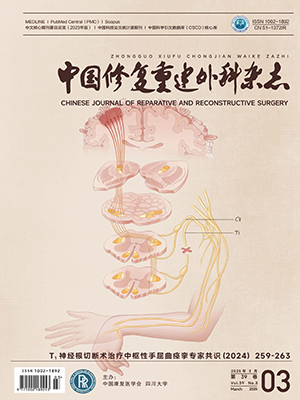| 1. |
Browner BD, Jupiter JB, Krettek C, et al. Skeletal trauma. 5th ed. Philadelphia: Elsevier, 2015: 54.
|
| 2. |
中华医学会骨科学分会创伤骨科学组, 中国医师协会骨科医师分会创伤专家工作委员会. 成人股骨颈骨折诊治指南. 中华创伤骨科杂志, 2018, 20(11): 921-928.
|
| 3. |
Parker MJ, Raghavan R, Gurusamy K. Incidence of fracture-healing complications after femoral neck fractures. Clin Orthop Relat Res, 2007, 458: 175-179.
|
| 4. |
Stoffel K, Zderic I, Gras F, et al. Biomechanical evaluation of the femoral neck system in unstable Pauwels Ⅲ femoral neck fractures: A comparison with the dynamic hip screw and cannulated screws. J Orthop Trauma, 2017, 31(3): 131-137.
|
| 5. |
Ju DG, Rajaee SS, Mirocha J, et al. Nationwide analysis of femoral neck fractures in elderly patients: A receding tide. J Bone Joint Surg (Am), 2017, 99(22): 1932-1940.
|
| 6. |
Wan L, Zhang X, Wu D, et al. Application of robot positioning for cannulated screw internal fixation in the treatment of femoral neck fracture: Retrospective study. JMIR Med Inform, 2021, 9(1): e24164. doi: 10.2196/24164.
|
| 7. |
黄波, 荣绍远, 李建华, 等. 双平面机器人导航辅助下空心钉内固定治疗股骨颈骨折. 中华骨科杂志, 2017, 37(9): 528-534.
|
| 8. |
刘建全, 刘黎军, 黄俊锋, 等. 机器人导航定位系统辅助下经皮空心螺钉内固定治疗股骨颈骨折. 中华创伤骨科杂志, 2015, 17(8): 692-698.
|
| 9. |
Florschutz AV, Langford JR, Haidukewych GJ, et al. Femoral neck fractures: current management. J Orthop Trauma, 2015, 29(3): 121-129.
|
| 10. |
Fixation using Alternative Implants for the Treatment of Hip fractures (FAITH) Investigators. Fracture fixation in the operative management of hip fractures (FAITH): an international, multicentre, randomised controlled trial. Lancet, 2017, 389(10078): 1519-1527.
|
| 11. |
Shen M, Wang C, Chen H, et al. An update on the Pauwels classification. J Orthop Surg Res, 2016, 11(1): 161. doi: 10.1186/s13018-016-0498-3.
|
| 12. |
Nibe Y, Matsumura T, Takahashi T, et al. A comparison between the femoral neck system and other implants for elderly patients with femoral neck fracture: A preliminary report of a newly developed implant. J Orthop Sci, 2021. doi: 10.1016/j.jos.2021.04.016.
|
| 13. |
熊巍, 易敏, 龙成, 等. 股骨颈动力交叉钉系统与倒三角形空心螺钉固定治疗成人股骨颈骨折的疗效比较. 中华创伤骨科杂志, 2021, 23(9): 748-753.
|
| 14. |
许翔宇, 周方, 田耘, 等. 股骨颈动力交叉钉系统与动力髋螺钉固定治疗股骨颈骨折的早期疗效比较. 中华创伤骨科杂志, 2021, 23(9): 754-760.
|
| 15. |
He C, Lu Y, Wang Q, et al. Comparison of the clinical efficacy of a femoral neck system versus cannulated screws in the treatment of femoral neck fracture in young adults. BMC Musculoskelet Disord, 2021, 22(1): 994. doi: 10.1186/s12891-021-04888-0.
|
| 16. |
周方. 股骨颈骨折治疗的热点与创新. 中华创伤骨科杂志, 2021, 23(9): 742-747.
|
| 17. |
Hofstetter R, Slomczykowski M, Sati M, et al. Fluoroscopy as an imaging means for computer-assisted surgical navigation. Comput Aided Surg, 1999, 4(2): 65-76.
|
| 18. |
Wolinsky PR, McCarty E, Shyr Y, et al. Reamed intramedullary nailing of the femur: 551 cases. J Trauma, 1999, 46(3): 392-399.
|
| 19. |
Karthik K, Colegate-Stone T, Dasgupta P, et al. Robotic surgery in trauma and orthopaedics: a systematic review. Bone Joint J, 2015, 97-B(3): 292-299.
|




